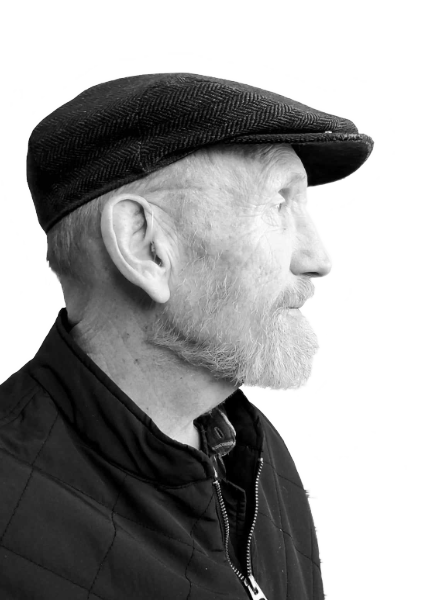About PRI
These images, correctly imagined, call upon the sensory wisdom of our “right brains,” that part of our thinking that is visual and holistic as opposed to verbal and linear. The exercises are largely based on illustrations of a the simplest version of a four-legged creature, what I call an “archetypal tetrapod.”

This creature represents a “map” of our own body surface—and our evolutionary history—simplified. The exercises in PRI provide a challenging but ultimately rewarding way to experience the body. If practiced with diligence, the use of Posture Release Imagery can result in a much improved posture and a more graceful yet sturdy sense of ourselves.
History and Discovery
Years ago (1992), I was giving a lesson in the Alexander Technique to a young theater student. I was working with him seated in a chair and having difficulty getting him to “lighten up.” When my verbal suggestions and light (but still novice) hands-on cues failed to produce change, I happened to suggest that he imagine that he is a cheetah looking over a savanna for prey. Being a suggestion (an image) I had heard from a teacher before, it obviously worked for him in a way that my earlier approaches had not. He “shot up” in stature (without leaving the chair). This event of providing a student with “colorful” direction marked the beginning of years of experimentation with imagery… and numerous new levels of excitement and understanding in my work as well as pain relief and freedom within myself.
The development of the imagery initially began as a result of my effort to describe the Alexander Technique through illustration to people unfamiliar with it. Musing on my own drawings of simplified evolution brought about my first new principle, which relates to the appropriate relationship between the dorsal and ventral surfaces of the body. This principle partly sprang from contemplating a portion of a principle of the Alexander Technique, which was “… back to lengthen and widen.” From there grew an awareness that imagery could provide new knowledge and additional principles of healthy posture and body use.
About John Appleton

I was born and grew up in Denver, Colorado. I graduated from Colorado State University in 1967. Since the years following this graduation, I have been on a quest for greater understanding of mind/body unity. Along the trail were experiences in and study of Reichian therapy, encounter group therapy, Rolfing, Tai Chi, and the Alexander Technique. I was certified as a teacher of the Alexander Technique in 1986 following a three-year training course with Joan and Alex Murray. In addition, years spent as a carpenter were valuable in providing me numerous opportunities to experience the physics of use and the exhilaration in the physical. (of physical movement?)
Finally, what should not be left out for this short bio is the added stimulus I had (to explore the mind/body connection wherever it led) from severe lower back pain a year or two before beginning training in the Alexander Technique. Pain can be a wonderful motivator.
Published editor-reviewed and peer-reviewed papers
- Appleton, J.A. (2004) Use and the Use of Imagery AmSAT News
- Appleton, J.A. (2006) Postulating that our neurological models for musculoskeletal support, movement, and emotional expression come from archetypal forms in early organisms
- Appleton, J.A. (2007) Illustrations and mental imagery of archetypal forms of early organisms – a new approach to exposing and releasing habitual and dysfunctional posture
- Appleton, J.A. (2007) Aspects of posture and personality described by a typology of muscle tonus patterns
Special Topics
-
Where is the Alexander Technique’s ‘right brain’? or Use and the use of imagery (2007)
This 13-page paper requires some familiarity with the Alexander Technique, since the article discusses strong parallels between the Alexander Technique and Posture Release Imagery.
-
Eyes are the Window to the… Head/Neck/Back Relationship (2008)
The habitual tonal quality around our eyes probably have the most powerful effect, of any specific body part, on our general posture and well-being. This 3-page paper contains illustrations and exercises that provide the experience of what I just stated. Anyone can benefit from this article and the exercises.
-
Imagery and “Neck Free, Head Forward…” (2008)
This 6-page paper with illustrations shows the relationship of some of my imagery to the Alexander Technique. (There is a couple of what I know consider inaccuracies in a couple of the drawings, but that does detract much from the information and exercises. Readers who work with my imagery will probably discover the changes in newer illustrations).
-
LIFE ON THE EDGE – of the dorsal/ventral seam (2010)
This 10-page article argues that the border on our bodies between their dorsal and ventral surfaces is very important to our perception, expression, and movement. Along this zone lie the most sensitive and expressive of our parts. Specific imagery suggested for this area is very liberating.
-
Self, Other, Earth, & Cosmos – and the Dorsal/Ventral Relationship (2010)
This is also a 10-page article with illustrations that covers most of my imagery and thinking concerning the dorsal/ventral relationship. (A more recent sequence if related imagery called the “Maturing of the Lamb” is not included but other spiritual or quasi-spiritual implications are included.
Interviews
With Alexander Technique Teachers
-
Interview with Luke Ford
Introduction to John Appleton and PRI
-
Interview 1 with Robert Rickover
Posture Release Imagery and how you can use it
-
Interview 2 with Robert Rickover
Using Posture Release Imagery for Better Health